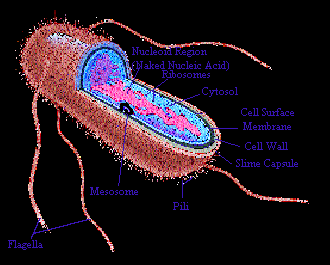

1) Ribosomes- A small Organelle constructed in the nucleoid, consisting of two subunits and functions as the site of protein synthesis in the cytoplasm. They are the free black dots in the cell diagram.
2) Mesosome- The infolding of a cytoplasmic membrane. Involved in the separation of chromosomes in reproduction. In the diagram, it is the black infolding of the cell surface membrane.
3) Cell Surface Membrane- First, if not only, layer of every living cell, prokaryotic or eukaryotic, that acts as a selective barrier. It lets certain substances leave and enter the cell. Regulates the cell's chemical composition. The third outermost layer in the diagram.
4) Cell Wall- A protective layer external to the plasma membrane and internal to the slime capsule in prokaryotes. Also found in eukaryotes such as plants, fungi, and some protists. Protects and supports the organism. It is the second outermost layer in the diagram.
5) Slime Capsule- Secretion by prokaryotes of sticky substances that form another protective layer outside of the cell wall. Enable the organisms to adhere to their substrate and provide additional protection, including an increased resistance of pathogenic bacteria to host defenses. The outermost layer of the prokaryotic cell in the diagram above.
6) Flagellum- A long cellular appendage specialized for locomotion. Formed from a core of nine outer doublet microtubules and two inner single microtubules, ensheathed in an extension of plasma membrane. Helps to move the cell by whipping the appendage back and forth. They are the long thin strands extending from the cell in the cell diagram.
7) Plasmid- Plasmids are circular, double-stranded DNA molecules capable of replication within living cells. Although not essential for the survival of their host, they may encode a wide variety of genes that increase survival in adverse environmental conditions. They are not represented in the diagram because they are very small.
8) Naked Nucleic Acid- They are the DNA usually found in the nucleus of eukaryotes but in prokaryotes they are in the nucleoid. Naked Nucleic Acids serve as the genes (chromosomes) that control the cell. It is the entire pink area in the cell diagram.